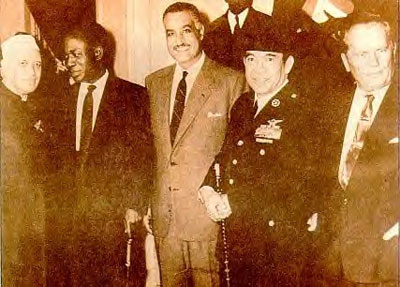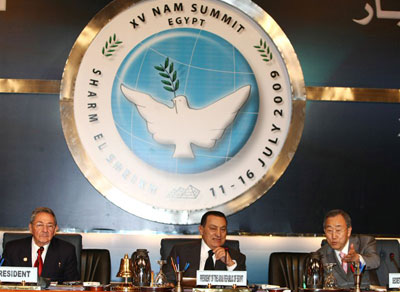The Non-Aligned Movement (NAM) is in search of new relevance. The bipolar tensions that gave it a place in the world have disappeared, and the series of "G" groups — G8, G14, and G20 — have become the favoured forums for contacts between the developed and developing world.
Still, NAM represents more than half the population of the world, and the recent Sharm el-Sheikh summit might have imbued it with a new sense of purpose.

In 1955, when the founding fathers of the Non-Aligned Movement (NAM) held their first meeting in Bandung, Indonesia, the role of the new organization seemed pretty clear. In a world still recovering from the ravages of World War II, the Soviet Union and United States had embarked on a new kind of military and political confrontation: the Cold War. The place of a non-aligned movement was to keep the two opposite blocs in equilibrium and prevent the cold war from turning hot.
After the fall of communism and the dissolution of the Warsaw Pact in 1991, NAM suddenly seemed out of place in a world without a bipolar military or ideological confrontation. Many even urged the organization to close up shop.
But NAM has a chance to play a new historic role: to help build a multipolar world.
A New Non-Aligned Movement?
At a first glance, NAM still seems to be a global force. It has 118 member states and another 15 observers waiting for admission. The organization represents almost 55% percent of the world population and 20% percent of the global economy.
At the same time, the Non-Aligned Movement still suffers from the same weaknesses that reduced its influence during the Cold War period. The five founding fathers of Bandung — Josif Broz Tito of Yugoslavia, Jawaharlal Nehru of India, Gamal Nasser of Egypt, Sukarno of Indonesia, and Kwame Nkrumah of Ghana — imagined a powerful military, political, and economical alliance that could balance United States and Soviet Union. This strong alliance was never built. The political connections among NAM members are still weak, there is no economic plan for common development, and no trade agreement or economic project holds together the membership. Also, the Movement does not offer a mechanism for addressing political conflicts between member states, and there is no common military capacity to give relevance to the organization. Bilateral agreements among members cannot substitute for common political, economic, and military mechanisms. At the moment, NAM lacks a constitution, a permanent secretariat, or the material resources to put forward a common international agenda.
A final challenge has been the weakness of Cuba, the country that has chaired NAM from 2006 until this summer. The three years of Cuban leadership has witnessed a decline in visibility and international audience for the organization. Egypt took over in July and, so far, its leadership has not been any more inspiring. So, NAM has a lot of work to do before it can measure up to NATO or the various U.S. coalitions of the willing.

NAM Renaissance?
Despite these internal issues, NAM under the Cuban presidency did advance a few initiatives that increased the image and influence of the organization. The most important was the decision of NAM to get involved in the necessary but long-postponed reform of the United Nations. NAM has been closely tied to the UN from its beginnings, and the UN general secretary is always invited to the triennial meeting. Recently, the Movement has become a kind of reform club with the UN with its championing of the elimination of the Security Council veto, a permanent seat in the UN Security Council for all the continents (South Africa or Nigeria for Africa, India for Asia, Brazil for South America) and a greater voice for the General Assembly.
Taking part in common peacekeeping operations has also provided some useful military experience. Finally, the NAM committee on Palestine has put forward a credible solution to the Middle East problem: calling on Israel to to halt its settlement activities, open up border crossings, cease the use of force and violence against civilians, and relinquish Gaza and West bank territories to a future Palestinian state while also urging Palestinians to recognize Israel, stop violent activities, and accept a two-state solution.
NAM has also engaged in internal reform. It created a joint economic cooperation committee and a joint coordinating committee that has doubled the number of states leading the organization. By making the decision-making more transparent and streamlined, for instance through the elimination of the veto, these changes have made the organization more efficient and consequently more visible.
Equally important was NAM’s decision to emphasize respect for fundamental human rights in line with the UN Charter. In so doing, it sought to distance itself from its earlier reputation as a club of autocrats. Of course NAM is still far from being a club of democracies, but it is at least moving in the right direction.
The Non-Aligned Movement played a part during the Cold War and now has a new calling: fostering a new era of multipolarism. The last decade of U.S. unipolarism was not a beneficial one. We witnessed an increase in global military spending, wars in Afghanistan and Iraq, and the destabilizing of the Middle East. There was the global recession, persistent underdevelopment in Africa and elsewhere, and several major democratic crises. The Non-Aligned Movement can help address these problems by shifting the world from its dangerous unipolarism to a more equitable distribution of political power and economic wealth in a new multilateral era.
==
Related article:
Secretary-General Ban Ki-moon: Speech to the High-Level Segment of the 15th Non-Aligned Movement Summit, Voltaire Network, 15 July 2009.

 Articles by this author
Articles by this author Send a message
Send a message











Stay In Touch
Follow us on social networks
Subscribe to weekly newsletter